剑桥二上 family matters (2)-----lucky 教案
- 格式:pdf
- 大小:2.44 MB
- 文档页数:10
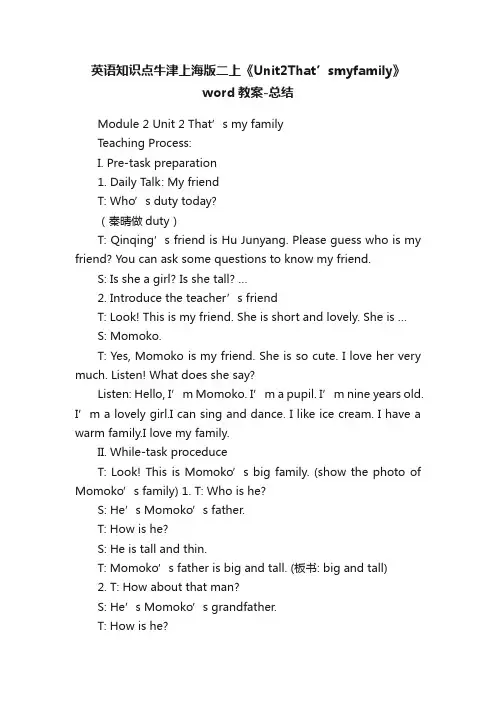
英语知识点牛津上海版二上《Unit2That’smyfamily》word教案-总结Module 2 Unit 2 That’s my familyTeaching Process:I. Pre-task preparation1. Daily Talk: My friendT: Who’s duty today?(秦晴做duty)T: Qinqing’s friend is Hu Junyang. Please guess who is my friend? You can ask some questions to know my friend.S: Is she a girl? Is she tall? …2. Introduce the teacher’s friendT: Look! This is my friend. She is short and lovely. She is …S: Momoko.T: Yes, Momoko is my friend. She is so cute. I love her very much. Listen! What does she say?Listen: Hello, I’m Momoko. I’m a pupil. I’m nine years old. I’m a lovely girl.I can sing and dance. I like ice cream. I have a warm family.I love my family.II. While-task proceduceT: Look! This is Momoko’s big family. (show the photo of Momoko’s family) 1. T: Who is he?S: He’s Momoko’s father.T: How is he?S: He is tall and thin.T: Momoko’s father is big and tall. (板书: big and tall)2. T: How about that man?S: He’s Momoko’s grandfather.T: How is he?S: He is short and thin.T: Yes, and he is old. (板书: old)Teach: old1) read and spell ( cold hold fold )2) Ask & answer: Who is old in your family? My ______ is old in my family.3. T: Who is she?S: She is Momoko’s gr andmother.T: How is she?S: She is old and short.T: Is she old?S: No.T: She is Momoko’s sister. She isn’t old. She is young. (板书:young)Teach: young 1) read and spell2) Make a new rhyme:Young, young , I am yong; Young, young, my mother is young; Young, young, my father is young. Young, young, we are all young.T: Her sister is thin and nice. She is young. (板书:thin and nice)4. Try to say: Young or old 1) Grandfather is old. Sister is young2) The doctor is old. The worker is young.3) Lan Yangyang is young. Man Yangyang is old.5. Play a game: Say opposite wordsT: Now let’s play a game. I say:old. You say: young. OK?(Review the opposite words: tall – short fat – thin young –old big –small good – bad )6. Try to say: My grandfather is old but I am young.My mother is short but my father is tall.…7. T: Look! This is Momoko’s mother. How is she?S: She is short and young.T: She is very kind and dear. (板书:kind and dear)Teach: kind 1) Read and spell2) Ask and answer:T: Who is kind in your class? ______ is kind in my class. T each: dear 1) Read and spell2) Read the phrase: kind and dear8. Rhyme:T: Look! It’s a rhyme. Who can read it?Mummy, mummy, kind and dear;Mummy, mummy, I love you.Daddy, daddy, big and tall;Daddy, daddy, I love you.8. T: Here’s Momoko. How is she? (板书:sweet and small)9. T: Momoko is happy in the warm family. Listen! Here’s a rhyme! (听录音)1) Listen to the tape.(She’s my mummy, Kind and dear. He’s my daddy, Big and tall. She’s my sister, Thin and nice. He’s my brother, Swe et and small.)2) Ask and answerT: How is Mummy? How is brother?3) Read after the tape4) Read the rhyme together.III. Post-task activities1. T: Momoko’s have a warm family. And every body has different family. Let’senjoy their smiles. (播放照片)2. Talk about the teacher’s family photoT: What do you want to know about my family? You can ask some quesitons. S: Who is he? ….Is he …?3. Introduce family membersT: Now let me introduce my family.Hello, I’m Jessie. This is my family. It’s small and warm. This is my baby. He is a boy. He is young and short. He is lovely. He can ride a bicycle. But he can’t skip the rope. He likes noodles. I love my baby.4. T: Now take out your family photos, choose one family member to introduce. Hello, I’m … This is my family. It’s … and … This is my … He/ She is … He/She is … He/She can … but he/ she can’t … He/ She likes … I love my …5. T: Here’s a poem for you.Father, father, Big and tall,Raise me up like a trunk;Mother, mother, Thin and nice,Care me a lot like the leaves;Baby, baby, Small and cute,Smile so sweet like a flower. T: Love your family! Be kind to your family members!。
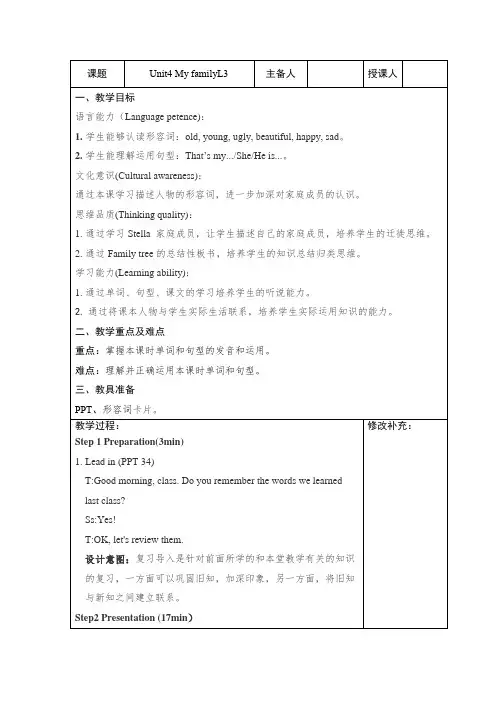
1.Happy(PPT56)(5min)T:Today I’m very happy, because I met you guys again! Are you happy?Ss: Yes.T:If you are happy,please clap your handsSs:(clap hands)T:Good. Now let’s follow the song, and do the action.(播放完后可以教师可以加指令“Stomp your feet.”)T:If you are happy, please say “happy”.T:What does this man feel? Is he happy?S:No.2.Sad(PPT78)(4min)T: No, he’s sad.T:Look at the monsters. He is___. She is____.T:Good. Now l et’s listen to a song, and tell me what will the monster do when he feels happy or sad?3.Ugly and beautiful(PPT910)(4min)T: I believe you are happy, but this duck is not. Why?Ss: Because He is ugly.T: Look,how about this swan?Ss: She is beautiful.4.Old and young(PPT11)(4min)T:How about them?(出示照片,让学生比较)Ss:年轻和老的。
(教授young和old)设计意图:两两比较突出强调人物的某种特征,使形象更加鲜明,加强学生对形容词的理解。
Step3 Practice(10min)1.I say,you do(PPT12)(3min)T:Now I say, you imitate and do.(边说形容词边做动作。
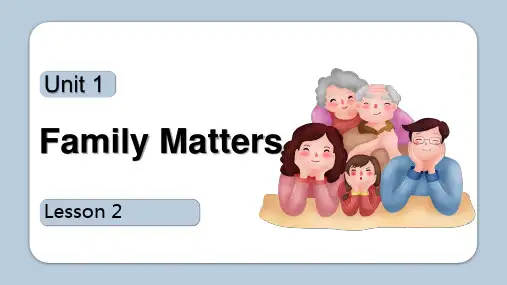
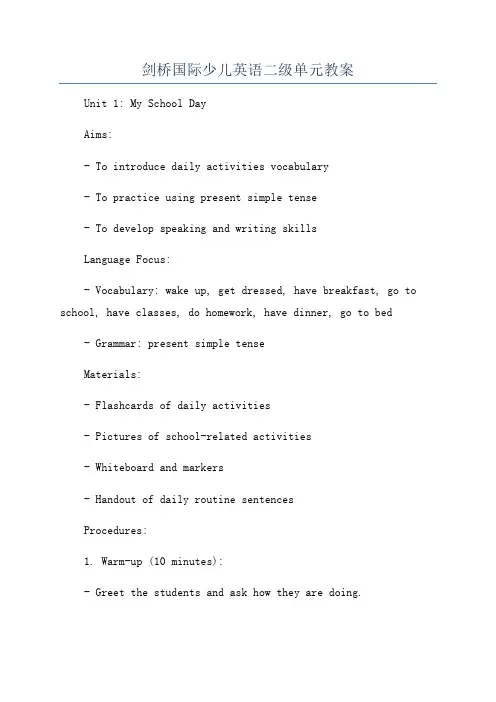
剑桥国际少儿英语二级单元教案Unit 1: My School DayAims:- To introduce daily activities vocabulary- To practice using present simple tense- To develop speaking and writing skillsLanguage Focus:- Vocabulary: wake up, get dressed, have breakfast, go to school, have classes, do homework, have dinner, go to bed - Grammar: present simple tenseMaterials:- Flashcards of daily activities- Pictures of school-related activities- Whiteboard and markers- Handout of daily routine sentencesProcedures:1. Warm-up (10 minutes):- Greet the students and ask how they are doing.- Play a quick game of Simon Says using actions related to the daily activities vocabulary (e.g. Simon says "wake up," Simon says "get dressed," etc.)2. Presentation of Vocabulary (15 minutes):- Show flashcards of the daily activities vocabulary and elicit the words from the students.- Drill the vocabulary pronunciation and have the students repeat after you.- Use the flashcards to create simple sentences and ask students to match the sentences with the corresponding pictures.3. Practice of Vocabulary (20 minutes):- Divide the class into pairs or small groups and give each group a set of pictures of school-related activities.- In turns, students should describe a picture to their partner/group using the daily activities vocabulary.- The partner/group should guess the activity being described.4. Introduction of Present Simple Tense (10 minutes):- Write examples of daily routine sentences on the whiteboard using the present simple tense (e.g. I wake up at 7:00 am, I go to school at 8:00 am, etc.).- Explain that we use the present simple to talk about routine actions that happen regularly.- Drill the sentences and have the students practice saying them out loud.5. Controlled Practice of Present Simple Tense (25 minutes):- Hand out the daily routine sentences worksheet to each student.- Monitor the students' progress and provide assistance as needed.6. Production Activity (15 minutes):- Divide the class into small groups and ask them to create a dialogue about their daily routines using the vocabulary and present simple tense.- Encourage the use of questions and answers in their dialogues.- Choose a few groups to perform their dialogues in front of the class.7. Wrap-up (5 minutes):- Review the vocabulary and present simple tense by asking students questions about their daily routines.- Thank the students for their participation and summarize the key points covered in the lesson.Note: This lesson plan is designed for a 60-minute class. It can be modified to suit different class durations and teaching styles.。

剑桥二级标准教案09.10.14Unit1 I’ve got many new friendsTeaching Aims :1.会用英语做简单的自我介绍2.更深的理解like 的用法3.会用句型I have got (会用单三人称及复数人称替换)Main Contents :1. like + ①to do/②doing2. I've go t…/He's got .../She's got...新知识教授流程Greeting: Good morning. Glad to meet you.(My name is ... I am your new teacher .)New term is coming .I hope we have a good beginning. And I believe you can become better and better. All of us have a good time. (如果是新接的班,可以加入自己的自我介绍,也可让每个孩子做一个简单的自我介绍)Warm up: Never give up ! 永不言弃 !(可以用引导的方式,让孩子慢慢地猜出这句话的意思。
)Review:Like 的用法:(用TPR 教学)I like going shopping. (作出购物的动作)I like to sing. (做出唱歌的动作)可以用 "I do you say " 操练New Knowledge :1. Pt 1Today we have got some new friends. Here is their self-introduction. Open your book and turn to page 1 .Look at Part 1 .There are six children. I want someone to pretend them. Who wants to try?(找人扮演这些角色,读,并且翻译)然后让学生自己做自己的口头自我介绍。
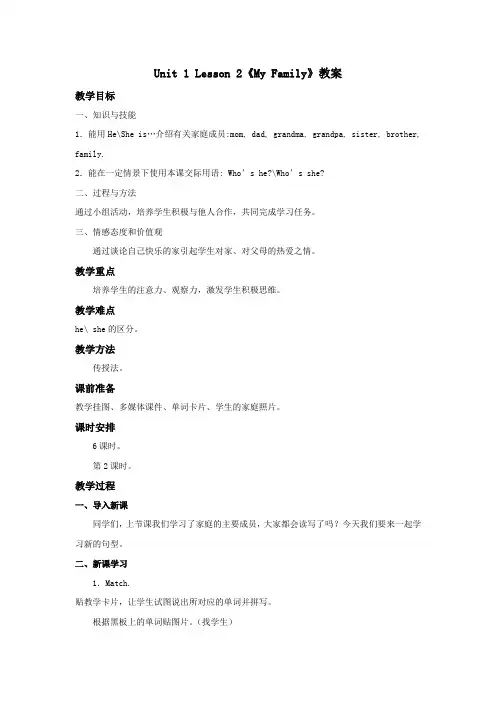
Unit 1 Lesson 2《My Family》教案教学目标一、知识与技能1.能用He\She is…介绍有关家庭成员:mom, dad, grandma, grandpa, sister, brother, family.2.能在一定情景下使用本课交际用语: Who’s he?\Who’s she?二、过程与方法通过小组活动,培养学生积极与他人合作,共同完成学习任务。
三、情感态度和价值观通过谈论自己快乐的家引起学生对家、对父母的热爱之情。
教学重点培养学生的注意力、观察力,激发学生积极思维。
教学难点he\ she的区分。
教学方法传授法。
课前准备教学挂图、多媒体课件、单词卡片、学生的家庭照片。
课时安排6课时。
第2课时。
教学过程一、导入新课同学们,上节课我们学习了家庭的主要成员,大家都会读写了吗?今天我们要来一起学习新的句型。
二、新课学习1.Match.贴教学卡片,让学生试图说出所对应的单词并拼写。
根据黑板上的单词贴图片。
(找学生)2.Learning.Listen to the tape and stand out when you hear your word. (扮演谁,听到后站出来) T: If you want to know the people in picture, how can you ask?S: Who’s he\she?Take some photos (单人或多人)and ask the student who has the photo.T: who’s he\she?S: He is…\She is…3.Practicing.(操练)Group work ——showT: Point the photo and ask your partner “who is he\she?”4.Guessing.教师说出班内某学生的外貌特征,其他学生猜。
T: who is he?学生当老师,重复以上练习。
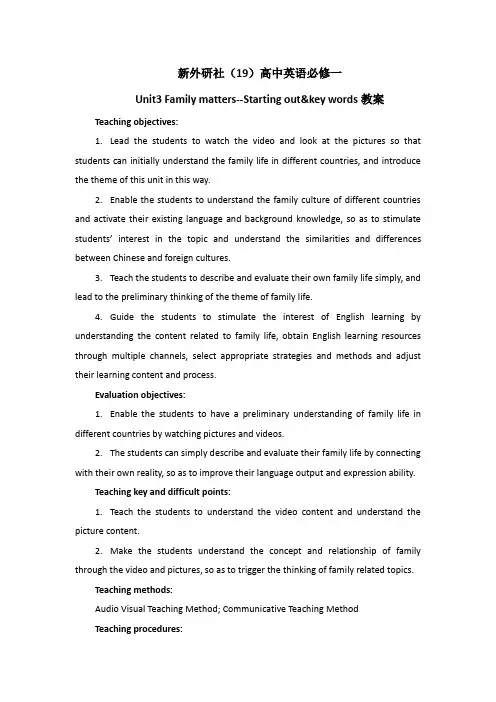
新外研社(19)高中英语必修一Unit3 Family matters--Starting out&key words教案Teaching objectives:1.Lead the students to watch the video and look at the pictures so that students can initially understand the family life in different countries, and introduce the theme of this unit in this way.2.Enable the students to understand the family culture of different countries and activate their existing language and background knowledge, so as to stimulate students’ interest in the topic and understand the similarities and differences between Chinese and foreign cultures.3.Teach the students to describe and evaluate their own family life simply, and lead to the preliminary thinking of the theme of family life.4.Guide the students to stimulate the interest of English learning by understanding the content related to family life, obtain English learning resources through multiple channels, select appropriate strategies and methods and adjust their learning content and process.Evaluation objectives:1.Enable the students to have a preliminary understanding of family life in different countries by watching pictures and videos.2.The students can simply describe and evaluate their family life by connecting with their own reality, so as to improve their language output and expression ability.Teaching key and difficult points:1.Teach the students to understand the video content and understand the picture content.2.Make the students understand the concept and relationship of family through the video and pictures, so as to trigger the thinking of family related topics.Teaching methods:Audio Visual Teaching Method; Communicative Teaching MethodTeaching procedures:Step1: Lead-inShow some posters of movies to the students, and let the students answer the question.1.Have you ever seen some films or comics about family?The names of the films:The pursuit of the happinessLife is beautiful.Change Jiang Qi HaoNezha:Birth of the Demon Child2.Can you tell the class why these films are so popular?Suggested answers:Because these films have one common topic about family and love between the families, which may deeply touch the audience for the reason that there is always love in everyone’s family.Step2:Activity2 on Page25The teacher shows the students some pictures about some classical families and asks them to give their answers.1.What do you already know about these families?Suggested answer:I am familiar with the Parr family in the Incredible .It tells the story about a superman family. Father used to be a superman spy who is warm-hearted, powerful and responsible. Mother is a superwoman who is busy looking after their three children in their happy life. Their three children all have various superpowers.They worked together to fight with the evil business man and successfully saved the world.I am deeply moved by the love between the family members.2.Which family do you relate to most?Give your reasons.Suggested answers:I relate to the Parr family most. I have a happy family with my parents and a little brother. My father is a kind and strong man and my mother is a happyhousewife who takes good care of the whole family. Although we may have some small quarrels in our daily life, we know we love each other very much.Step3:Activity1 on Page 25The teacher shows the video to the students and asks them to have a discussion to answer the two questions below after watching the video.1.What is the video mainly about?Suggested answer: It is about the gathering of a family. The grandpa comes to visit his son’s family. They send gifts of pictures and family tree to each other, which shows their deep love between the family members.2.How do you feel about the family?Suggested answer:This is a happy family in which the family members cherish and love each other.Step4: Discussion(Group work)Think about the topic of family, have a discussion and write something about your family stories, and then present in groups.Step5:Key wordsⅠ.写出下列词汇的汉语释义。
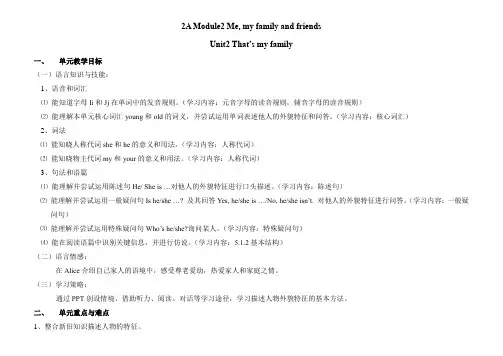
2A Module2 Me, my family and friendsUnit2 That’s my family一、单元教学目标(一)语言知识与技能:1、语音和词汇⑴能知道字母Ii和Jj在单词中的发音规则。
(学习内容:元音字母的读音规则,辅音字母的读音规则)⑵能理解本单元核心词汇young和old的词义,并尝试运用单词表述他人的外貌特征和问答。
(学习内容:核心词汇)2、词法⑴能知晓人称代词she和he的意义和用法。
(学习内容:人称代词)⑵能知晓物主代词my和your的意义和用法。
(学习内容:人称代词)3、句法和语篇⑴能理解并尝试运用陈述句He/ She is …对他人的外貌特征进行口头描述。
(学习内容:陈述句)⑵能理解并尝试运用一般疑问句Is he/she …? 及其回答Yes, he/she is …/No, he/she isn’t. 对他人的外貌特征进行问答。
(学习内容:一般疑问句)⑶能理解并尝试运用特殊疑问句Who’s he/she?询问某人。
(学习内容:特殊疑问句)⑷能在阅读语篇中识别关键信息,并进行仿说。
(学习内容:5.1.2基本结构)(二)语言情感:在Alice介绍自己家人的语境中,感受尊老爱幼,热爱家人和家庭之情。
(三)学习策略:通过PPT创设情境,借助听力、阅读、对话等学习途径,学习描述人物外貌特征的基本方法。
二、单元重点与难点1、整合新旧知识描述人物的特征。
2、学习运用句型Is he/she …?对他人的外貌特征进行问答。
三、单元语用任务在Alice介绍自己家人的语境中,运用本单元的核心语言知识,用至少3句话描述他人的外貌特征。
要求语音正确,内容基本达意,表达较流利。
四、分课时学习内容与要求(一)语音(二)词汇(三)词法(四)句法(五)语篇五、分课时教学与评价解析Period 1 文本Alice’s familyHello! I’m Alice. This is my sister. She is May. She is seven. She is short , thin and young. This is my brother. He is Ben. He is ten. He is tall, thin and young.This is my grandmother. She is old, fat and short.作业:Read the three introductions.S1: Who’s she?S2: She’s Sally.S1: Is she your sister?S2: Yes, she’s my sister. She is young.S1: Is she tall?S2: Yes, she is.S1: Is she fat?S2: No, she isn’t. She is thin. I like my sister.八、教学技术与学习资源1. 《义务教育英语课程标准》、《上海市中小学英语课程标准》(征求意见稿)2. 《上海市小学英语学科教学基本要求》(试验本)3. 《上海市小学低年段英语学科基于课程标准评价指南》(试行稿)4. 教材《牛津英语》(上海版)二年级第一学期(试用本)5. 教学板书6. 多媒体课件7. 评价单。
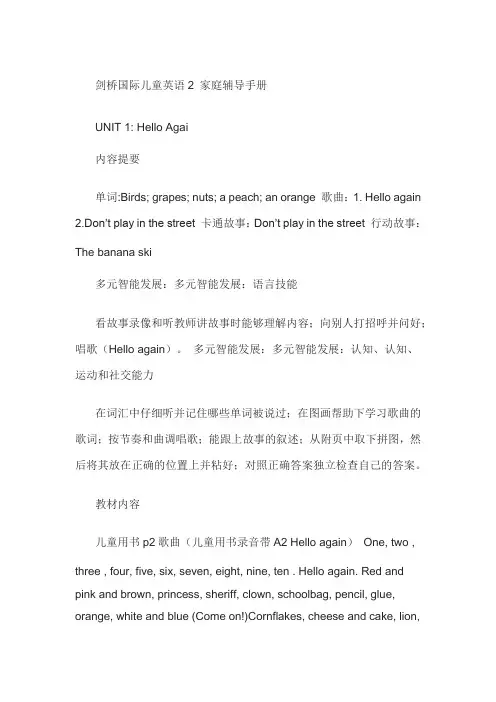
剑桥国际儿童英语2 家庭辅导手册UNIT 1: Hello Agai内容提要单词:Birds; grapes; nuts; a peach; an orange 歌曲:1. Hello again 2.Don’t play in the street 卡通故事:Don’t play in the street 行动故事:The banana ski多元智能发展:多元智能发展:语言技能看故事录像和听教师讲故事时能够理解内容;向别人打招呼并问好;唱歌(Hello again)。
多元智能发展:多元智能发展:认知、认知、运动和社交能力在词汇中仔细听并记住哪些单词被说过;在图画帮助下学习歌曲的歌词;按节奏和曲调唱歌;能跟上故事的叙述;从附页中取下拼图,然后将其放在正确的位置上并粘好;对照正确答案独立检查自己的答案。
教材内容儿童用书p2歌曲(儿童用书录音带A2 Hello again)One, two , three , four, five, six, seven, eight, nine, ten . Hello again. Red and pink and brown, princess, sheriff, clown, schoolbag, pencil, glue, orange, white and blue (Come on!)Cornflakes, cheese and cake, lion,hippo snake, rain and wind sun, jump and clap and run. (Come on!) Teddy bear and plane, puzzle, ball and train, dogs and cats and birds, we know lots of words.(Oh yes!儿童用书p3听力练习(儿童用书录音带A5What is it?)1. Boy: Close your eyes. Girl: Ok.Boy: Open your mouth. Girl: Mmh. Boy: What is it? Girl: A peach.Boy: That’s right.2. Boy: Close your eyes.Girl: Ok.Boy: Open your mouth. Girl: Mmh. Boy: What is it? Girl: A plum..Boy: That’s right.3. Boy: Close your eyes. Girl: Ok.Boy: Open your mouth. Girl: Mmh. Boy: What is it? Girl: A n orange.. Boy: That’s right.儿童用书p3听力迷宫(儿童用书录音带A5What’s on Max’s plate?)An orange, nuts, grapes, a pear, a peach. W hat’s on Max’s plate?儿童用书p4卡通故事(故事录音带1 Don’t play in the street)Storyteller: It’s morning. Time to go to school Linda: Have an apple, Max.Max: Thanks. One, two, three. Apples, apples, I like apples, I like apples…Linda and Benny: Stop it, Max.Max: App les, apples, I like…ooooh! My apple! Linda and Benny: Be careful, Max! Oh, Max. Max: Thanks Linda. Thanks Benny.Linda and Benny:Don’t play in the street Max! Max:Ok.儿童用书p5歌曲(儿童用书录音带A6 Don’t play in the street!)Don’t play in the street. Don’t play in the street. Don’t jump around and fight! Eyes wide open and ears wide open, look left and right, look left and right, look left and right. Oh yes! Don’t play in the street. Don’t play in the street. Don’t jump around and fight! Clever boys and clever girls, look left and right, look left and right, look left and right. Oh yes! Don’t play in the street. Don’t play in the street. Don’t jump around and fight!儿童用书p6行动故事(儿童用书录音带A8 The banana skin)Walk down the street. You’re hungry. Open your bag. Take out a banana. Peel it. Throw the skin away. Take aite and walk on. You slip on the banana skin. Ouch!活动用书p3听力练习(活动用书用书录音带A1 I’m 菜。
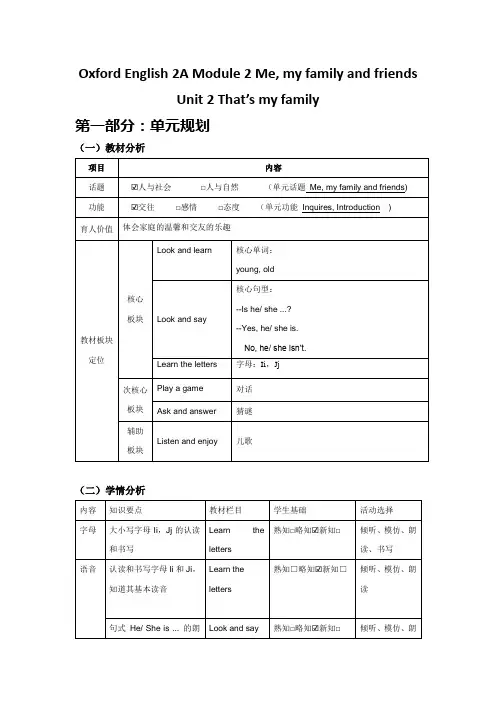
Oxford English 2A Module 2 Me, my family and friendsUnit 2 That’s my family第一部分:单元规划(一)教材分析(二)学情分析第二部分:单元教学目标●知识与技能1. 能知晓、背记字母Ii,Ji的音、形及其在单词中的基本读音,并能正确书写,能认读含有Ii, Jj的发音相关单词和儿歌。
2.能用升调朗读句型Is he/ she ...?;用降调朗读句型Yes, he/she is. No, he/she isn’t.。
3. 能在语境中知晓并理解young,old等外貌类单词。
能借助语境和媒介,运用外貌类单词介绍家人。
4.能借助语境和媒介,运用句型Is he/she...?询问他人的身份和外形特征,并用Yes, he/ she is. No, he/ she isn’t.进行正确应答。
5. 能在语境中,了解介绍家人的相关信息,并进行简单的对话交流。
●过程与方法1.通过模仿朗读、儿歌吟唱、问答归纳等形式学习语音,掌握其发音规律。
2.通过文本视听、跟读模仿、看图说话等形式学习本单元的相关单词。
3.通过对话朗读、问答交流、看图说话等形式学习本单元的核心句型。
4.通过图文朗读、阅读、信息寻找、问答交流等形式读懂语篇,尝试对话交流。
情感、态度、价值观体会家庭的温馨和交友的乐趣。
第三部分:分课时教学目标和文本内容Period 1 That’s Peter’s family【教学目标】•知识与技能1. 通过听读相关单词和儿歌,能认读和书写字母Ii,Jj,并感知它们在单词中的发音。
2.能正确地用降调模仿朗读句型Yes, he/ she is. No, he/she isn’t.。
3. 能在语境中初步运用句型Is he/she …?询问他人身份信息;初步运用句型Yes, he/sheis. No, he/she isn’t.来应答。
•过程与方法1. 通过倾听、模仿、跟读等形式学习字母。
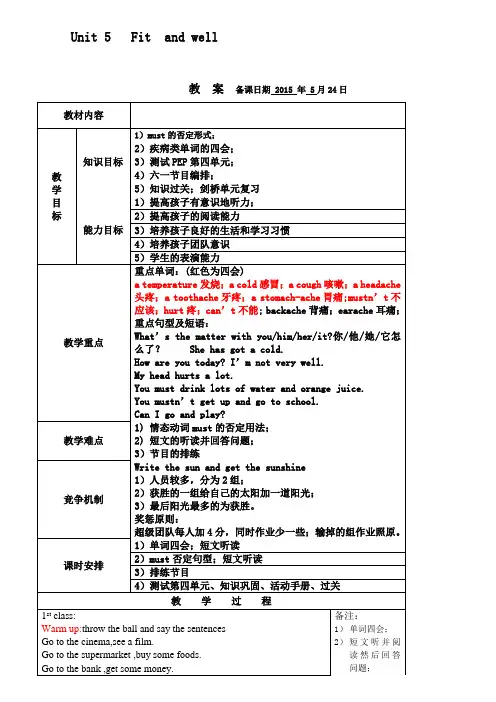
Unit 5 Fit and well教案备课日期 2015 年 5月24日教材内容教学目标知识目标1)must的否定形式;2)疾病类单词的四会;3)测试PEP第四单元;4)六一节目编排;5)知识过关;剑桥单元复习能力目标1)提高孩子有意识地听力;2)提高孩子的阅读能力3)培养孩子良好的生活和学习习惯4)培养孩子团队意识5)学生的表演能力教学重点重点单词:(红色为四会)a temperature发烧;a cold感冒;a cough咳嗽;a headache头疼;a toothache牙疼;a stomach-ache胃痛;mustn’t不应该;hurt疼;can’t不能; backache背痛;earache耳痛;重点句型及短语:What’s the matter with you/him/her/it?你/他/她/它怎么了? She has got a cold.How are you today? I’m not very well.My head hurts a lot.You must drink lots of water and orange juice.You mustn’t get up and go to school.Can I go and play?教学难点1) 情态动词must的否定用法;2) 短文的听读并回答问题;3)节目的排练竞争机制Write the sun and get the sunshine1)人员较多,分为2组;2)获胜的一组给自己的太阳加一道阳光;3)最后阳光最多的为获胜。
奖惩原则:超级团队每人加4分,同时作业少一些;输掉的组作业照原。
课时安排1)单词四会;短文听读2)must否定句型;短文听读3)排练节目4)测试第四单元、知识巩固、活动手册、过关教学过程1st class:Warm up:throw the ball and say the sentences Go to the cinema,see a film.Go to the supermarket ,buy some foods.Go to the bank ,get some money. 备注:1)单词四会;2)短文听并阅读然后回答问题;Go to the hospital ,see a doctor . ...............Scoring system: Write down the words见竞争机制)KPI: 培养孩子竞争意Step2:part1 read and order the words,Make sentences .Review unit 3and unit41)Write down some words in reserve order and then make sentences correctly.2Look at the ppt and review some key words and sentences .3)Do the activity book P42 part 1Step3:西方文化节宣传之希腊Class 2Step1:Warm-up; slogan; scoring systemWarm-up: Go to the bank. Get some money…KPI: 调节课前气氛,把学生的情绪调动起来,同时复习一下。
剑桥少儿英语二级教案剑桥少儿英语二级上Unit1 Where areyou going?教学目的和要求:1)使学生掌握本单元的重点句型ﻫ2)使学生初步学会并掌握有关地点的名称ﻫ3)使学生能用所学的句型、所学的地点名称做替换练习ﻫ交际句型:--------------Where are you going?----------------I' m going to school.ﻫﻫ交际词汇:post office, market, zoo,park, bus station, cafe,supermarket, hospital, cinema, bank,library, shop复习内容:物主代词my, your, his, her, their, our, itsﻫﻫ具体教学方式:ﻫ上课时,首先让大家看自己手中的图片,并对大家说:Hi, everyone, I've got many pictures. They are places. Do you know what they are? Now,look at this one.(拿出一个大家比较熟悉的地点---医院) Thisis a hospital. Do youthisone? Very good. It'sa school. It's a school. We are now inthe school.按照此种方法,可以把单词一一介绍给大家。
介绍时要注意与学生在情感上的交流。
如:This is a supermarket. Have you everbeen to a supermarket? What can you buy inthe supermarket? Is it far from your home?等。
语言要尽量简练,否则学生会有很多的听觉障碍。
ﻫﻫ学生把所有的地点学说几遍之后,教师说:Now I put these pictures in different places. And I'm going to ask you a question. Where are you going? You tell me ,"I'm going to the bank." Then you goand stand near the bank. Let's see which place has more people. Do you understand?Who wants to try first?OK, come here please. Everybody, listen! "Where are you going. Lin Feng?" "I'm going to the zoo." Very good. Now you can go tothe zoo and stand here.Do you understand us now?ﻫﻫ教师带领学生做几个示范之后,可以让某个学生到前面来做同样的练习。
小学二年级上册苏教牛津版《Myfamily》第二课时英语教案(1)份小学二年级上册苏教牛津版《My family》第二课时英语教案 1 教学目标:1.能听懂,会说,会读日常用语Who’s he? He’s my father. Who’s she? She’s my mother.2.能理解,分辨单词he和she.3.能用Who句型进行__对话。
重点难点:1.能理解,分辨单词he和she.2.能用Who句型进行__对话。
教学对策:要求学生自己带父母的照片,根据图片来进行教学。
教学准备:词语卡片、挂图教学过程:Step11.GreetingsT: Hello.Ss: Hello.2.Free talkT: I am a girl.S1: I am a boy.T-Ss S1-S2Step 21.Review the wordsT show picturesSs: father mother brother sisterGame:T: my fatherS1: my motherS2: my sister。
Rhyme (Say and act)2.New sentencesT: father, yes? Team cat?Ss: Yes.T: He is my father.Ss: read together.Read it in different ways. (lonely, groups, different voice)Game: Guess? Who’s he?T: Who’s he?S1: He’s my father。
.T: Let’s ask him together.Who’s he?Ss: follow.Ask one by one.T: He’s my dog. (picture)The same way to teacher: Who’s she? She’s my mother.Step 31.Read the sentences in different ways.2.he sheT: 小朋友们你们看看这两个单词,它们有什么不同点?谁来试试?S1: 。
剑桥国际少儿英语第二册文本k b2剑桥国际少儿英语KB2第一单元文本Unit 1 Hello again!1.Listen and point.Stella:Hello again! We’re the Star Family. I’m Stella Star and I’m eight. This is m y brother, Simon. He’s seven, and this is my sister, Suzy. She’s four.Simon: This is my grandmother. She’s grandma Star.Grandma: Hello.Simon: This is my grandfather. He’s grandpa Star. Simon: Grandpa, say hello. Grandpa: Oh! Hello, everybodyMrs Star: And we’re Mr and Mrs Star.Simon: What’s your name? How old are you.2. Listen, point and repeat.Stella Simon Suzy Mr Star Mrs star Grandma Star Grandpa Star Listen and answer. Trevor: Hello! I’m Trevor. Look at number four. Who’s he? Look at number one. Who’s she?Look at number eight. Who’s he?Look at number three.Who’s she?Look at number six. Who’s she?Look at number two. Who’s he?Look at number nine. Who’s she?Look at number ten. Who’s he?Look at number five. Who’s she?Look at number seven. Who’s he?(Answer: 4 Mr star, 1 Suzy, 8 Monty, 3 Stella, 6 Grandma Star, 2 Simon, 9 Marie , 10 Maskman, 5 Mrs Star, 7 Grandpa Star)剑桥国际少儿英语Unit2Back to school!1. Listen and point.Stella: Hello, Alex! Hello, Lenny! How are you?Alex and Lenny: Fine,thanks.Merra: Is this your classroom,Simon?Simon: Yes.Merra:Who’s that on the board?Simon:That’s my favourite toy, Maskman. Look at my Maskman ruler.Lenny: That’s nice. My ruler’s on my desk.Stella: Are your school books in the bookcase?Simon:No, they are in the cupboard. Our teach er’s here now.stella and Meera: Oops2.Listen, point and repeat.board bookcase cupboard desk ruler teacher6.Listen, point and repeat.There’s a long pink ruler on her desk.There are a lot of boos in the bookcase.The re’s a big whiteboard on the wall.There’s a computer in the classroom, but there isn’t a television. Unit 3 Play time!1.Listen and point.Suzy: Ooh, kites! Can we look at them, Dad?Mr Star: OK, Suzy. Where are they?Suzy: Over there! Next to the lorries.Simon: Look at these robots!Stella: Ugh! They’re ugly!Alex: I like this big yellow watch.Meera:Look at this camera. It’s orange, my favourite colour.Stella:Hum! … Look! Computer games! I love computer games! Simon: Great! Is there a Maskman Playbox?Stella:Yes, there is, and there’s a ‘Can you spell…?’ game.Meera, Alex, Simon: Ugh! Stella!2.Listen, point and repeat.Camera watch kite robot lorry computer game3.Listen, point and say the numbers.There are dolls.This is a robot.This is a train.This is a camera.These are lorries.This is a watch.This is a computer game.This is a kite.These are balls.4.Listen and say ‘yes’ or ‘no’ .There are two bid red lorries.(No-There’s a red lorry and a yellow lorry.) There’s a beautiful pink and purple kite. (Yes)There’s a Maskman computer game.(Yes)There’s an ugly robot with green eyes.(No-There’s an ugly robot with red eyes.) There’s a small orange camera.(Yes)There’s a clean orange camera.There are two small white balls.There are three happy dolls.There are two big yellow watches.There’s a long brown train.5.Listen, point and repeat.Toys in the toy box,Come alive,Walk and talk,On the count of five.One, two, three, four, five.Monty:Look at S uzy’s kite! It’s beautiful. It’s pink and purple with a long tail. Maskman: And it’s big, and it can fly. I can fly too. What’s that, Marie? Marie:It’s a ‘Can you spell…?’ computer game.Monty: Whose is it? Is it Suzy’s?Marie:No, it isn’t.It’s stella’s.Monty:What’s that under the table?Maskman:It’s Simon’s basketball.Monty:No, not that. What’s that new toy next to the ball?Marie: It’s a big robot. It’s‘Metal Mouth’.Maskman:Metal Mouth? Hmm, yes. It’s an ugly robot.Monty: Whose is it?Mask man:It’s Simon’s.Metal Mouth: My name is Metal Mouth. My name is Metal Mouth.Monty: Ooh, look! It can walk and talk.Maskman:Yes, but it’s can’t fly. I can fly.6.Listen, point and repeat.Look at Suzy’s kite.Whose is the computer game?It’s Stel la’s computer game.It’s Simon’s robot.Unit 4 At home!1.Listen and point.Stella: Can I play, Suzy?Suzy: OK!Stella:Where’s my bedroom?Suzy:It’s there, next to the bathroom.Stella:OK!Suzy: Put this blue mat on the floor next to your bed.Stella: Can I have a phone in my bedroom?Suzy:No, you can’t. The phone’s in the living room next to the sofa. Stella: Can I have a Lamp, please?Suzy: OK. You can put the lamp on the table next to your bed.Stella: Thanks, Suzy. Where can I put the armchair?Suzy: Put it in the living room under the clock.Stella: Is there a mirror in my bedroom?Suzy:A mirror in your bedroom? No, there isn’t. There are three mirrors. one in t he bathroom, one in my bedroom and one in Simon’s bedroom.Stella: Oh.2.Listen, point and repeat.mat lamp clock phone mirror sofa4.Listen and correct.There’s a girl sitting on the sofa.(No, there isn’t.There’s a boy sitting on the sofa.)There’s a mirror in the living room.(No, there isn’t.There’s a a mirror in the bathroom.)There’s a phone in the bedroom.(No, there isn’t.There’s a phone in the hall.)There’s a boat on the bed.(No, there isn’t.There’s a boat in the bath.)There’s a sofa in the hall.(No, there isn’t.There’s a sofa in the living room.)There’s a lamp under the window.(No, there isn’t.There’s a lamp on the table.)There’s a clock next to the bath.(No, there isn’t.There’s a clock on the wall.)There’s a boy sitting on the bed.(No, there isn’t.There’s a girl sitting on the bed.)5.Listen and correct.Grandpa: Simon! Stella! Can you take your clothes to your bedrooms, please? Simon and stella: OK!Grandpa: Whose T-shirt is that?Stella: Which T-shirt?Grandpa: The yellow one.Stella:It’s Suzy’s.Simon:No, it isn’t.It’s mine.Stella: No, Simon. That T-shirt’s very small. Yours is the big yellow one over there.Simon: Oh! Yes!Grandpa: OK. Are those blue socks yours, Simon?Simon:No, they aren’t mine. They are Dad’s.Grandpa: What now? Oh, yes! Whose black trousers are those?Stella and Simon:They’re yours, Grandpa.Grandpa:Oh, yes! That’s right, they are.6.Listen, point and repeat.Grandpa: Whose T-shirt is that?Simon: It’s mine.Grandpa: Whose black trousers are those?Stella and Simon:They’re yours, Grandpa.Unit 5 Meet my family1.Listen and point.Stella:Look, Lenny’s with Frank’s mum and dad.Simon:Who’s Frank?Stella:Frank’s Lenny’s baby cousin.Meera: Oh, how old is he?Stella:He’s one.Simon: How many cousins have you got, Meera?Meera: Six: four boys and two girls. How many cousins have you got?Simon:None, but we’ve got a baby. Her name’s Suzy.Suzy:I’m not a baby. I’m a big girl! Grandpa! Simon says I’m a baby.Grandpa:Simon, as you’re a big boy, you can fly Suzy’s kite with her. Here you a re!Simon: Puph! Thank you!2.Listen, point and repeat.mummy daddy grandma grandpa cousin baby3.Listen, point and answer.He’s Lenny’s daddy. What’s his name? (Nick)She’s Frank’s cousin. What’s her name?(May)He’s Kim’s brother. What’s his name? (Ben)She’s Lenny’s sister. What’s her name? (May)She’s Frank’s mummy. What’s her name? (Lucy)He’s May’s cousin. What’s his name? (Frank)He’s Frank’s grandpa. What’s his name? (Nelson)She’s Sam’s grandma. What’s her name? (Anna)5. Listen and say the numbers.Lenny’s hitting the ball.(16)The dog’s getting the ball. (19)The boy’s mother is cleaning his mouth. (14)The baby’s sleeping. (11)Simon’s throwing the ball. (15)The girl’s kicking the football. (18)Frank’s mum and dad are talking. (12)Meera’s catching the ball. (17)Grandpa’s flying a kite. (13)The cat’s jumping. (20)Unit 6 Dinner time1.Listen and point.Simon: What are you doing, Dad?Mr Star:’m making dinner. This evening we’ve got bread and water.Stella:No, we can’t have bread and water for dinner, Dad. We have bread and m ilk for breakfast.Suzy:Hmm. Milk’s my favourite drink.Simon:Orange juice is my favorite drink.Suzy: So, what is fou dinner, Dad?Simon:Let’s have egg and chips.Suzy:Let’s have chocolate cake!Mr Star: No, Suzy. Chocolate cake’s for tea.All three children: So, what for dinner?Mr Star:Hmm… for dinner? It’s your favourite, it’s my favourite, it our favourite. T his evening we’ve got…Dad’s Star dinner!... Chicken and rice!Stella, Simon and Suzy: Lovely.2.Listen, point and repeat.bread water milk juice chicken eggs chips rice5.Listen and answer.Mr Star: Come on, everybody. Sit down. It’s dinner time.All three children: OK, Dad.Suzy: Can I have some fruit juice, please, Mum?Mrs Star: Yes, Suzy. Orange juice or apple juice?Suzy: Orange juice, please.Mrs Star: Here you are.Suzy: Thank you! //aStella: Can I have some brown bread, please?Mrs Star: Here you are.Stella: Thanks! //bSimon: Can I have some egg and chips, please?Mr Star:No, Simon. I’m sorry. It’s chicken and rice for dinner tonight, but, if you’r e good, you can have chocolate ice cream after.Simon:Hmm, great! Chocolate ice cr eam’s my favourite.6.Listen, point and repeat.Suzy: Can I have some fruit juice, please, Mum?Mrs Star: Here you are.Stella: Can I have some brown bread, please?Mrs Star: Here you are.7.Listen and say ‘yes’ or ‘no’.Marie:I’m having chicken and rice. (No. I’m having tomatoes and carrots.)Monty: Can I have some milk, please? (No. Can I have some apple juice, please ?)Maskman: Is there any chocolate cake? (Yes.)Trevor:Yes, there is. (No. No, there isn’t.)Monty:No, it isn’t mine. It’s Trevor’s. (No. No, it isn’t mine. It’s Marie’s.)Trevor: Er, no. It isn’t chicken. It’s a long brown pencil. (Yes.)Unit 7 At the farm (在农场)1.Listen and point.Suzy: Look at all those animals. This is a nice zoo.Mr Star:It isn’t a zoo. It’s a farm. Look- there’s a cow under the tree. Simon: Uh oh! Mum! The goat’s eating your bag.Mrs Star: Aaahh! Shoo! Shoo! Stop that!Stella: Look, Suzy. The baby sheep are drinking milk.Suzy: Ahhh!Mr Star: Let’s give the ducks some bread.Suzy:There’s a frog!Simon:Look, Stella. There’s a lizard on your T-shirt!Stella: Ha,ha,Simon. Very funny! I know, and I love lizards. Doyou like spiders, Simon?Simon:No, I don’t.Stella:Oh. Well, there’s a big, black, ugly spider in your hair.Simon: Ahh!2.Listen, point and repeat.cow duck goat lizard sheep spider frog5.Listen and answer.Toys in the toy box, Come alive. Walk and talk,On the count of five, One, two, three, four, five.Marie:Trevor, can I have the sheep, please? Let’s put it here, next to the cows. Trevor: Here you are.Monty: Oh, I love sheep. Baa, baa.Trevor: So do I.Maskman:I don’t. I love horses.Marie: So do I.Trevor:I don’t. Horses are very big and they can kick.Maskman: What now?Monty: Le t’s put the goat under the tree.Marie: No, Monty. It can eat the flowers and I love flowers. Maskman: So do I. Trevor: Flowers, Maskman? Do you love flowers? Maskman: Yes, I do. I can give them to Marie. Monty and Trevor: Oooohhh!6. Listen, point and repeat.Monty: Oh, I love sheep. Baa, baa.Trevor: So do I. Maskman: I love horses. Trevor: I don’t.1102 剑桥国际少儿英语2 Unit8文本Unit 8 My town1. Listen and point.Suzy: This is a long street, grandpa.Grandpa: Yes, it is. It’s a big city. Can you see me flat? Suzy: No. Where is it? Grandpa:It’s over there, next to the park. It’s the with the green windows. Suzy: Oh, yes. What’s this over here, next to the toy shop. Grandpa: That’s a ho spital.Suzy: Ooh, look! There’s a shoe shop! Look at those beautiful red shoes, grandp a. Grandpa: What…? Oh, yes.Suzy: The shoe shop’s next to the café, Grandpa. Grandpa: Good idea. Let’s go t o the café for a drink. Suzy: No, grandpa. Let’s go to the shoe shop for my new r ed shoes.Grandpa: Oh, sorry… Ye s…Of course.2. Listen, point and repeat.park shop street hospital café flat5. Listen and ponit.Narrator: Mr Star is playing his guitar at Simon and Stella’s school. Simon’s sittin g between Stella and Suzy, and Mrs Star’s sitting next to Suzy. Lenny’s sitting in front of Mrs Star, andLenny’s mum’s sitting between Lenny and his dad. Grandpa and Grandma Star a re sitting behind Simon and Suzy. Everybody is very happy, but Suzy isn’t. Stella: I love music.Mrs Star: So do I. Suzy: Mum, I can’t see. Mrs Star: Shh, Suzy. Be quiet.Suzy: But, I can’t see. Lenny’s mum’s in front of me. Grandma: Shh, Suzy. Be qui et. I can’t hear if you’re talking. Suzy: Can I sit with Stella, please? Mrs Star: Well , all right, but be quiet. Suzy: Yes, mum. Thanks.Suzy: Oh, this is good. Now I can see.Stella: Huh! You can see, but I can’t, Mum!1102 剑桥国际少儿英语2 Unit9文本Unit 9 Our clothes1. Listen and answer.Stella: Hello and welcome to the Star Fashion Show. Here are Simon and Alex. T hey’re wearing black shirts, blue jeans and white shoes. Simon’s got small black sunglasses on his head. Alex is wearing a new yellow watch. Thank you, Simon. Thank you, Alex.Now here’s Meera. She’s wearing a short brown skirt and an orange jacket. She’s wearing long yellow socks and green shoes. Thank you, Meera.Now we’ve got Suzy, the star of the show. She’s wearing a long purple dress and big pink shoes. She’s wearing a nice big red hat and she’s got beautiful gold handbag. Thank you, Suzy. Now here’s Lenny. He’s wearing grey trousers, black sh oes, and a red T-shirt with a green lizard on. What a beautiful T-shirt! Thank you, Lenny.2. Listen, point and repeat. dress glasses handbag hat shirt jeans4. Listen and correct.1. These’s a big box with toys. (No, there’s a big box with cothes.)2. Three boys are wearing jeans. (No, one boy is wearing jeans.)3. Two girls are wearing red jeans. (No, one girl is wearing red shoes.)4. Five children are wearing glasses. (No, four children are wearing glasses.)5.One girl’s wearing a dress. (No, two girls are wearing a dress.)6. There are six handbags. (No, there are four handbag.)7. Two boys are wearing short trousers. (No, one boy is wearing short trousers.)8. There are five hats. (No, there are four hats.)5. Listen and point.Toys in the toy box, Come alive. Walk and talk, On the count of five, One, two, th ree, four, five.Trevor: Your know, Maskman, we’ve got a good life. We’ve got a nice family and we’ve got a lot of friends.Maskman: I know, Trevor, and we’ve got a house and a garden with lots of trees and beautiful flowers.Marie: Yes, a lot of toys haven’t got a house or a garden… Maskman: Or a car. I’ve got a big car. Have you got a car, Trevor?Trevor: No, I haven’t got a car. I can’t drive.Maskman: I’ve got superhero clothes. Have you got superhero clothes, Trevor? Trevor: No, I haven’t.I’m not a superhero.Monty: Marie’s a doctor. She’s got a long white jacket and glasses. Maskman: Yes, I’ve got black glasses, too.Trevor: Yes, Maskman, we’ve got a good life. We’ve got a nice dog too. Look, the re she is.Maskman: Aaaghh!!... And she’s got a big mouth. Others: Ha ha ha!6. Listen, point and repeat.Trevor: We’ve got a nice family and we’ve got a lot of friends. Maskman: Have yo u got superhero clothes, Trevor? Trevor: No, I haven’t.I’m not a superhero. Monty: Marie’s a doctor. She’s got a long white jacket and glasses.1102 剑桥国际少儿英语KB2 unit10文本Unit 10 Our hobbies1. Listen and answer.Suzy: Stella, I’ve got a book about sports. What are these sports?Stella: The man with the hat’s hitting the ball. He’s playing baseball, and this man here’s playing basketball. He’s bouncing the ball.Suzy: What are Lenny and Simon doing? Stella: They’re playing hockey. Suzy: Are grandpa and Alex playing tennis? Stella: No, they’re playing badminton . Suzy: Grandma’s painting. Is painting a sport? Stella: No, it isn’t, Suzy. It’s a ho bby.Suzy: Merra’s taking a photo. I s that a sport or a hobby? Stella: It’s a hobby, Suz y.Suzy: W hat’s your favourite hobby, Stella? Stella: It’s reading, … and yours? Suzy: My favourite hobby? … Er …It’s, er … talking. Stella: Yes, it is.2. Listen, point and repeat.painting badminton table tennis hockey baseball basketball 3. Listen and say the hobby.1. She’s bouncing the ball. Now she’s throwing it to her friend.2. He’s throwing the small ball to his friend … Yes, She’s hitting it. Oh! Yes …now she’s catching the ball.3. They’re playing with a small ball. They’ve got a big table between them and the ball’s bouncing on the table.4. They aren’t playing with a ball. They’re hitting a small white object. It isn’t bo uncing and they aren’t catching it.5. She’s running and kicking the ball. The ball isn’t bouncing and they aren’t ca tching it.6. They’re running with a small ball. He’s hitting it with a long stick.(6 basketball, 3 baseball, 4 table tennis, 1 badminton, 5 football, 2 hockey)5. Listen and point.Mr Star: Hi. My name’s Bruce Star. I like playing the guitar and I love cooking, but I don’t like riding horses. Mrs Star: Hi. I’m Angelina Star. I love riding horses and reading, but I don’t like cooking.Grandpa: Hello. I’m Grandpa Star. I like fishing and playing badminton, but I don’t like cleaning my shoes.Grandma: Hello. I’m Grandma Star. I love painting and driving, but I don’t like gar dening.Stella: Hi. I’m Stella. I love playing the piano and I like reading about sports, but I don’t like doing sport.Simon: Hello. My name’s Simon. I like playing basketball and hockey, but I don’t l ike cleaning my room.Suzy: Hi. I’m Suzy. I love singing and drawing, but I don’t like playing soccer.. 6. They’re running with a small ball. He’s hitting it with a long stick.(6 basketball, 3 baseball, 4 table tennis, 1 badminton, 5 football, 2 hockey)5. Listen and point.Mr Star: Hi. My name’s Bruce Star. I like playing the guitar and I love cooking, but I don’t like riding horses. Mrs Star: Hi. I’m Angelina Star. I love riding horses and reading, but I don’t like cooking.Grandpa: Hello. I’m Grandpa Star. I like fishing and playing badminton, but I don’t like cleaning my shoes.Grandma: Hello. I’m Grandma Star. I love painting and driving, but I don’t like gar dening.Stella: Hi. I’m Stella. I love playing the piano and I like reading about sports, but I don’t like doing sport.Simon: Hello. My name’s Simon. I like playing basketball and hockey, but I don’t l ike cleaning my room.Suzy: Hi. I’m Suzy. I love singing and drawing, but I don’t like playing soccer.. Alex: Hello. I’m Alex. I like playing badminton and I love playing the piano, but I d on’t like playing baseball. Lenny: Hi. My name’s Lenny. I like swimming and playi ng football, but I don’t like playing table tennis.Meera: Hello. I’m Meera. I like riding my bike and I love taking photos, but I don’t like watching TV.11. Listen and say ‘yes’ or ‘no’.1. What a great game of soccer! Yes! What a great goal! (Yes)2. Number 8 is kicking the ball. Now number 5 is hitting the ball with his head. ( No-18 and 15)3. No, Maskman! You can’t touch the ball with your head! (NO-hands)4. Now number 15 is running with the ball. (Yes)5. Trever! Are you eating the book? (No-ball)6. Come and play badminton with us, Marie! (No-football)1107剑桥国际少儿英语Unit11文本Unit 11 My Birthday! 我的生日1. Listen and answer.Simon: What are you cooking?Mr Star: I’m cooking burgers and sausages. Simon: Are we having chips too? Mr Star: Yes, we’re having fries. Grandma’s getting them from the kitchen. Grand pa’s helping her.Simon: Yum, yum. And we’ve got lemonade to drink. Suzy: Mummy, is there any fruit juice? Mrs Star: Yes, I can get it for you. Suzy: T.hanksStella: What are you doing, Meera? Meera: I’m trying to take a photo of Simon. Alex: Yoo hoo, Meera! We’re in front of you. Take a photo of us. Stella: No, don’t take a photo of them. Take one of Simon. Meera: I’m trying to take a photo of him . Alex, Lenny, can you stand behind me, please? I don’t like taking ugly photos.2. Listen, point and repeat.sausages burgers cake watermelon oranges lemonade4. Read and answer.1. He’s cooking the burgers and saussages.2. Meera’s taking photos.3. He’s got a nice new bike.4. It’s blue.5. He’s eight.5. Listen and answer. Toys in the toy box, Come alive. Walk and talk, On the c ount of five, One, two, three, four, five.Trevor: Monty, what would you like to eat? Would you like a burger or a sauage? Monty: I’d like a sausage, please, Trevor. Trevor: Here you are. Monty: Thanks.Maskman: Can I have a sausage and a burger, please? Marie: One moment, ple ase, Maskman. It’s not your turn.Monty: Er, here you are, Maskman. Would you like some fries too? Maskman: Ye s, I’d love some. Lots, please, Monty.Trevor: Marie, what would you like to drink? Marie: I’d like some fruit juice, please , Trevor. Maskman: Can I have some lemonade, please?Monty: Maskman, please would you like to wait a moment. It’s not your turn. Maskman: Oh, sorry.Monty: Would you like some fries too, Trevor? … Please. Trevor: Er … Well … O k, Monty. Fries aren’t my favourite food, but … for you.6. Listen, point and repeat.Trevor: Would you like a burger or a sauage? Monty: I’d like a sausage, please, Trevor. Trevor: Here you are.Maskman: Can I have some lemonade, please?1107剑桥国际少儿英语Unit12文本Unit 11 On holiday! 度假1. Listen and answer.Lenny: We’re on holiday! Great!Simon: I love holidays. Lenny: So do I.Simon: I love playing on the beach. The clean, yellow sand, the big sun, the beau tiful, blue sea. I love swimming in the sea.Lenny: Er, the beach is OK, but I love walking in the mountains. There are lots of green trees and beautiful flowers. Simon: What! Flowers, Lenny?Lenny: Well, yes, er … flowers and animals, big animals. Simon: Hmm. I like fishi ng with my grandpa. We can’t fish in the city.Lenny: Dose Stella and Suzy like fishing?Simon: Oh, no. Suzy like picking up shells from the beach and Stella loves sitting in the sun and reading.Lenny: Come on, Simon. Let’s go! We’re on the holiday! Simon: Yeh!2. Listen, point and repeat.beach sand sea shell sun mountain5. Listen and answer.Mrs Star: Well, children. It’s the end of the school. Where do youwant to go on holiday? Simon: Let’s go to the beach.Stella: Oh, I want to go to the mountains this year. I want to draw birds and trees and I want to watch small animals. I’d like a new notebook and pencils, please. Suzy: Are there shells in the mountains, Stella?Stella: No, there aren’t, but you can get lots of beautiful flowers. Mr Star: Do you want to go to a big city? We can walk in the streets and sit in cafe.All: Oh, no! We don’t want to go to a city.精品文档Simon: OK, let’s go to the mountains. Can we swim there, Mum? Mrs Star: Yes, you can.Mr Star: OK, that’s good. We’re all happy to go to the mountains for our holidays.Stella: So can I have a new notebook and pencils, then? Simon: Well, I want som e new sunglasses, please. Suzy: And I want a new sunhat, please. Grandpa: Hm m, and now I want my dinner.7. Listen and say the letter.1. Which melon do you want? I want the big green one.2. Which shoes do you want? I want the red ones.3. Which monster do you want? I want the ugly one.4. Which ice cream do you want? I want the lemon one.5. Which apples do you want? I want the green ones.6. Which doll do you want? I want the happy one.7. Which cake do you want? I want the small one.8. Which shoes do you want? I want the white one.收集于网络,如有侵权请联系管理员删除。
剑桥少儿英语二级教案标题:剑桥少儿英语二级教案教案概述:本教案旨在为剑桥少儿英语二级学生设计一节有趣、互动和有效的英语课程。
通过结合听、说、读、写等多种教学方法,培养学生的英语听说能力,提高他们的词汇量和语法理解能力。
本教案将通过主题为"家庭"的课程,帮助学生学习家庭成员的称呼、描述家庭成员的特征,以及表达自己的家庭情况。
教学目标:1. 学习并能正确使用家庭成员的称呼,如father, mother, brother, sister等。
2. 能用英语描述家庭成员的特征,如年龄、外貌特征等。
3. 能够用简单的英语表达自己的家庭情况,如家庭人数、家庭成员的职业等。
4. 提高学生的听力和口语交流能力。
5. 培养学生的团队合作和互动能力。
教学准备:1. 教学课件或投影仪。
2. 学生练习册和教材。
3. 卡片或图片,用于展示家庭成员的称呼和特征描述。
4. 录音设备,用于录制听力材料。
教学过程:1. 热身活动 (5分钟)- 引导学生唱一首关于家庭的歌曲,如《We Are Family》。
- 通过问答的方式,复习家庭成员的称呼。
2. 听力训练 (10分钟)- 播放录音,让学生听到一段描述家庭成员特征的对话,要求学生根据听到的内容,选择正确的图片或卡片。
- 通过多次听和练习,帮助学生提高听力理解能力。
3. 词汇和句型引入 (10分钟)- 展示卡片或图片,教授家庭成员的称呼和特征描述的词汇。
- 模仿对话,引导学生运用所学词汇和句型进行简单的问答练习。
4. 口语练习 (15分钟)- 分成小组,让学生互相介绍自己的家庭成员和家庭情况。
- 鼓励学生使用所学词汇和句型进行对话练习,提供必要的帮助和指导。
5. 阅读理解 (10分钟)- 分发练习册上的阅读材料,让学生阅读并回答相关问题。
- 通过阅读理解训练,巩固学生对家庭成员特征的理解和运用能力。
6. 语法拓展 (10分钟)- 引导学生观察家庭成员的称呼和特征描述中的语法规律,如人称代词的使用等。
剑桥二级上册教案教案:剑桥二级上册 Unit 1教学目标:1. 学习新词汇,提高单词记忆能力。
2. 通过课堂练习和小组活动,培养学生的听说能力。
3. 了解不同国家的文化和风俗习惯。
教学步骤:Step 1: Lead-in (5 minutes)通过图片和问题引导学生进入主题,激发学生学习英语的兴趣。
例如:展示一张中国地图,问学生中国的首都是哪里。
Step 2: Vocabulary (10 minutes)教授新词汇,使用图片和例句帮助学生理解和记忆单词。
例如:展示一张图片,让学生猜测单词的意思,然后教授该单词的正确发音和意思。
Step 3: Listening (15 minutes)播放录音,让学生听对话并回答问题,提高学生的听力能力。
例如:播放一段对话,询问学生对话中的所属国家。
Step 4: Speaking (15 minutes)将学生分成小组进行对话练习,提高学生的口语表达能力。
例如:让学生用英语简单介绍自己的国家,包括国家的位置和风俗习惯。
Step 5: Reading (10 minutes)让学生阅读课本中的短文,并回答一些问题,加深对文章内容的理解。
例如:让学生读一篇关于英国的短文,并回答英国的首都是哪里。
Step 6: Writing (15 minutes)要求学生用英语写一篇关于自己国家的短文,提高学生的写作能力。
例如:让学生写一篇关于中国的短文,包括中国的地理位置、人口、主要城市等内容。
Step 7: Homework (5 minutes)布置作业,让学生复习本课所学内容,并写一篇关于自己国家的短文。
教学反思:通过本节课的教学活动,学生能够学习和记忆新词汇,提高听说能力,了解不同国家的文化和风俗习惯。
通过小组讨论和个人写作练习,学生能够在实际情境中灵活运用所学知识,培养语言交流和表达的能力。
课后布置的作业能够巩固学生的理解和记忆,并促进学生的自主学习。